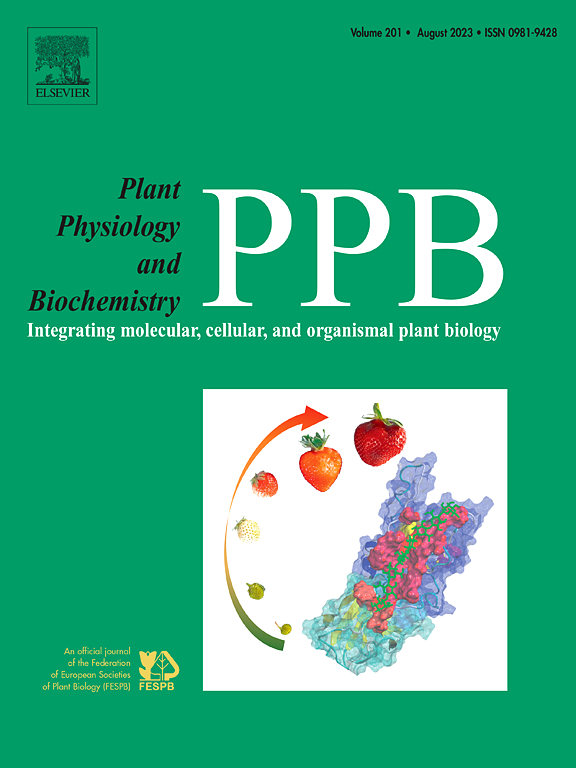Potassium silicate and/or silicate-solubilizing bacteria stimulate Cuscuta campestris germination but mitigate oxidative stress induced by it on Guizotia abyssinica
IF 6.1
2区 生物学
Q1 PLANT SCIENCES
引用次数: 0
Abstract
Environmental and economic considerations have heightened interest in silicate-solubilizing bacteria (SSB) as an alternative to silicon nanoparticles in agricultural crop production. However, related research has not considered the response of weeds to silicon. This study, conducted at three levels: laboratory, greenhouse, and field, examines whether K2SiO3 and/or SSB affect the seed germination of dodder and niger, as well as their parasitic relationship. In the laboratory, a germination test was performed for each species with and without 1 mM K2SiO3 or 0.1 % v/v SSB. In the greenhouse and field studies, niger was grown with and without dodder, K2SiO3, or SSB. Combined use of K2SiO3+SSB synergistically increased seed germination for niger and dodder by 12.3 and 142.6 %, while accelerating the process by 39.5 and 43.6 %, respectively. The invasion of dodder, when paired with K2SiO3 and/or SSB, significantly increased the activity of superoxide dismutase and catalase in niger. Untreated niger contained 213.6 mg silicon kg−1 dry weight. Dodder alone reduced it by 38.5 %, but when combined with K2SiO3+SSB, a 2.2-fold increase in the silicon content of niger occurred. Dodder-parasitized niger treated with K2SiO3+SSB exhibited over a 3-fold increase in lignin content and phenylalanine ammonia-lyase activity. The highest emergence of dodder was recorded when SSB was used alone or in combination with K2SiO3. Although dodder-parasitized niger treated with K2SiO3+SSB experienced more infestation due to the increased emergence of dodder, it yielded a higher seed than untreated niger, indicating a mitigated oxidative stress induced by dodder in niger through both physical and biochemical mechanisms.
硅酸钾和/或硅酸盐增溶菌对赤豆萌发有促进作用,但对赤豆氧化应激有缓解作用
环境和经济方面的考虑提高了人们对硅酸盐增溶菌(SSB)作为农业生产中硅纳米颗粒替代品的兴趣。然而,相关研究尚未考虑到杂草对硅的响应。本研究在实验室、温室和田间三个层面进行,研究了K2SiO3和/或SSB是否会影响菟丝子和尼日尔种子的萌发,以及它们的寄生关系。在实验室中,对每一种种子进行了萌发试验,试验中分别添加和不添加1mm K2SiO3或0.1% v/v SSB。在温室和田间试验中,尼日尔分别在添加和不添加菟丝子、K2SiO3或SSB的情况下生长。K2SiO3+SSB复合施用可使黑草籽和菟丝子种子萌发率分别提高12.3%和142.6%,加速萌发率分别提高39.5%和43.6%。当菟丝子与K2SiO3和/或SSB配对时,菟丝子的入侵显著提高了尼日尔超氧化物歧化酶和过氧化氢酶的活性。未经处理的尼日尔含有213.6 mg硅kg - 1干重。菟丝子单独处理可使硅含量降低38.5%,而与K2SiO3+SSB复合处理可使硅含量增加2.2倍。经K2SiO3+SSB处理的菟丝子寄生黑草木质素含量和苯丙氨酸解氨酶活性均提高3倍以上。单用SSB或与K2SiO3配伍时,菟丝子出苗率最高。虽然经K2SiO3+SSB处理的菟丝子寄生的黑莓因菟丝子出苗率增加而受到更大的侵染,但其种子产量高于未处理的黑莓,表明菟丝子诱导的氧化应激在物理和生化机制上都得到了缓解。
本文章由计算机程序翻译,如有差异,请以英文原文为准。
求助全文
约1分钟内获得全文
求助全文
来源期刊
CiteScore
11.10
自引率
3.10%
发文量
410
审稿时长
33 days
期刊介绍:
Plant Physiology and Biochemistry publishes original theoretical, experimental and technical contributions in the various fields of plant physiology (biochemistry, physiology, structure, genetics, plant-microbe interactions, etc.) at diverse levels of integration (molecular, subcellular, cellular, organ, whole plant, environmental). Opinions expressed in the journal are the sole responsibility of the authors and publication does not imply the editors'' agreement.
Manuscripts describing molecular-genetic and/or gene expression data that are not integrated with biochemical analysis and/or actual measurements of plant physiological processes are not suitable for PPB. Also "Omics" studies (transcriptomics, proteomics, metabolomics, etc.) reporting descriptive analysis without an element of functional validation assays, will not be considered. Similarly, applied agronomic or phytochemical studies that generate no new, fundamental insights in plant physiological and/or biochemical processes are not suitable for publication in PPB.
Plant Physiology and Biochemistry publishes several types of articles: Reviews, Papers and Short Papers. Articles for Reviews are either invited by the editor or proposed by the authors for the editor''s prior agreement. Reviews should not exceed 40 typewritten pages and Short Papers no more than approximately 8 typewritten pages. The fundamental character of Plant Physiology and Biochemistry remains that of a journal for original results.

 求助内容:
求助内容: 应助结果提醒方式:
应助结果提醒方式:


